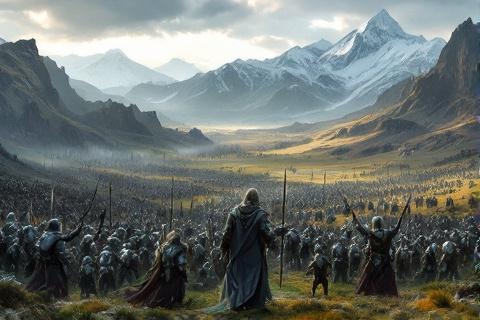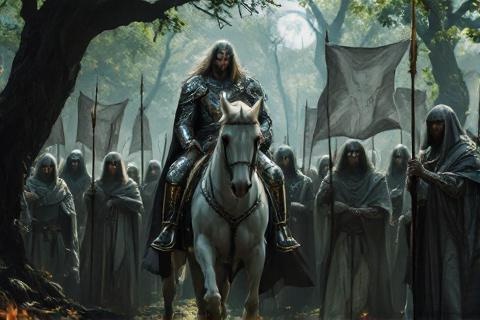
The First Battle of Beleriand
Elves Confront the Armies of Morgoth
The Dawn of Conflict in Beleriand

Before Morgoth's return to
Middle-earth, the realm of the Sindar in
Beleriand was a peaceful kingdom under the rule of King
Thingol and Queen Melian. The Sindar, also known as the Grey-elves, had
established prosperous settlements throughout the vast lands, particularly
centered around the great forest of Region and Neldoreth, which would later
become known as Doriath. These Elves lived in harmony with
nature, developing their crafts and culture under the starlight before the first
rising of the Sun.
Following his theft of the Silmarils and flight from
Valinor, Morgoth reestablished his ancient fortress of
Angband in the Iron Mountains of the far north. The evil
Vala fortified the great towers of Thangorodrim above his
subterranean stronghold, creating an impregnable base from which to launch his
campaigns against the Elves of Beleriand. The three peaks of Thangorodrim,
raised from the slag and debris of his underground works, stood as a visible
symbol of his power and malice.
Within the depths of Angband, Morgoth began breeding and multiplying his evil
creatures in preparation for war. The Dark Lord corrupted and twisted captured
Elves into the first Orcs, created vast breeds of wolves, and spawned other fell
creatures in the darkness beneath the mountains. These armies grew in number and
strength while remaining hidden from the eyes of the Elves, who were initially
unaware of the full extent of the threat building in the north.
The Forces of Darkness Emerge
The first signs of Morgoth's aggression came in the form of probing attacks by
Orc-bands into East Beleriand, targeting the more isolated settlements and
testing the Elves' defenses. These initial raids were swift and brutal, catching
many of the peaceful Sindar unprepared for such violence. The attacks primarily
focused on the regions furthest from Thingol's seat of power, where the Elven
presence was less concentrated.
Morgoth's strategy in launching these preliminary assaults was carefully
calculated to assess the military capability and response times of the Elven
realms. The Dark Lord sought to understand the strength of his opponents while
simultaneously spreading fear and confusion among the Elvish populations. His
forces would strike suddenly before withdrawing, gathering intelligence about
the Elves' defensive capabilities and organizational structure.
As the attacks intensified, evil creatures began to multiply and spread
throughout the northern lands of Beleriand. Wolves and other fell beasts roamed
the highlands around Mount Dolmed and the northern plains, making travel
increasingly perilous. The darkness under the trees grew deeper, and many of the
previously safe paths became dangerous as Morgoth's influence expanded southward
from Angband.
King Thingol Musters His Forces

In response to the growing threat, King Thingol organized the first formal
military structure among the Sindar, establishing companies of armed warriors
trained specifically for combat against Morgoth's forces. The king drew upon the
hunting skills of his people, transforming them into disciplined military units
capable of defending their realm. These armies were equipped with spears, bows,
and swords crafted by the skilled smiths of Doriath.
The marchwardens of Doriath, led by experienced warriors, took on a crucial role
in defending the realm's borders. These skilled scouts and fighters maintained a
constant vigilance along the frontiers of Thingol's kingdom, developing
sophisticated systems of warning and defense. Their knowledge of the forest
paths and expertise in woodland warfare proved invaluable in protecting their
people from the encroaching darkness.
Thingol strategically deployed his forces along the northern borders of his
realm, establishing a series of defensive positions and patrol routes. The Elven
warriors were stationed at key crossing points and potential invasion routes,
creating a defensive network that could quickly respond to any incursion. This
military organization represented a significant shift from the peaceful
existence the Sindar had previously known.
The Green-elves of Ossiriand
The Laiquendi, or Green-elves, who dwelt in Ossiriand played a unique and vital
role in the First Battle of Beleriand. These woodland folk, though less numerous
than the Sindar, possessed an intimate knowledge of the eastern forests and
rivers that proved invaluable in the conflict. Their involvement began when
Orc-raids threatened their homeland between the rivers of East Beleriand.
The Green-elves developed effective guerrilla warfare tactics that took
advantage of their superior knowledge of the forest terrain. They were masters
of stealth and ambush, using their understanding of the woodland environment to
trap and eliminate enemy forces with minimal casualties to their own people.
Their archers were particularly skilled at striking from concealment and
withdrawing before the enemy could respond.
The Laiquendi formed a crucial alliance with Thingol's forces, coordinating
their actions with the larger Sindarin army. This cooperation allowed them to
funnel enemy forces into prepared killing zones and prevent Morgoth's armies
from establishing any permanent footholds in the eastern regions. Their
partnership with the Sindar demonstrated the effectiveness of combining
different fighting styles and tactical approaches.
The Battle Begins

The first major clashes of the battle occurred in the eastern regions of
Beleriand, where Morgoth's forces attempted to establish control over the
strategic river crossings. The Sindar and their allies met these advances with
fierce resistance, utilizing their superior knowledge of the terrain to counter
the numerical advantage of the Orcs. These initial encounters set the pattern
for much of the subsequent fighting.
Both sides employed distinct tactical approaches during the early fighting. The
Orcs relied on their superior numbers and brute strength, attempting to
overwhelm the Elven positions through sheer force. In contrast, the Elves
utilized their greater mobility and archery skills, engaging in hit-and-run
attacks that gradually wore down the enemy forces. The Sindarin warriors proved
particularly effective at night fighting, turning one of the Orcs' traditional
advantages against them.
As the battle intensified, the conflict spread across multiple fronts, with
simultaneous engagements occurring throughout East Beleriand. The Elves
demonstrated remarkable coordination between their various forces, using a
system of signals and swift messengers to maintain communication and respond
rapidly to new threats. This allowed them to concentrate their strength where it
was most needed while maintaining defensive positions across a broad front.
Circle of Fate in the East
The turning point of the battle came when the Elven forces managed to encircle
several large Orc-hosts in East Beleriand. Through careful maneuvering and
coordination between the Sindarin armies and the Laiquendi, they trapped
significant portions of Morgoth's forces against the rivers of Ossiriand. This
encirclement prevented the Orcs from receiving reinforcements or retreating to
safety.
The Green-elves demonstrated the effectiveness of their guerrilla tactics during
this phase of the battle, using their intimate knowledge of the river valleys to
deadly effect. They guided the retreating Orcs into prepared ambush sites where
Thingol's forces waited to strike. Their archers positioned themselves in the
trees, raining arrows upon the confused and increasingly desperate enemy forces.
The combined pressure from multiple directions led to the complete routing of
the Orcish armies from the eastern regions. Many of the surviving Orcs fled
northward in disarray, with the Elven forces in close pursuit. Those who
attempted to stand and fight were systematically eliminated by the coordinated
attacks of the Sindarin warriors and Green-elven archers.
The Defense of Doriath

During the battle, Queen Melian's power played a crucial role in protecting the
central realm of Doriath. The Maia used her considerable magical
abilities to shield the heart of Thingol's kingdom from direct assault, creating
an unseen barrier of power and enchantment. This protection allowed the Sindarin
armies to operate more freely, knowing their homeland was secure from enemy
incursion.
The establishment of the Girdle of Melian marked a significant development in
the defensive capabilities of Doriath. This magical boundary, an impenetrable
maze of shadow and bewilderment, prevented any from entering the realm without
the permission of King Thingol or Queen Melian. The Girdle would prove to be one
of the most effective defenses against Morgoth's forces throughout the First
Age.
Doriath's position as a secure stronghold in central Beleriand provided the
Elves with a crucial strategic advantage. The realm served as a safe haven where
forces could regroup and supplies could be gathered without fear of enemy
interference. This security allowed Thingol to project his power more
effectively across Beleriand while maintaining a protected base of operations.
Victory and Aftermath
The final phase of the battle saw the complete routing of Morgoth's armies from
Beleriand. The coordinated efforts of the Sindarin forces and their allies drove
the surviving Orcs back toward Angband, inflicting heavy casualties during their
retreat. The pursuit was relentless, with the Elven forces showing no mercy to
the fleeing enemy.
In the aftermath of the battle, the Elves began the solemn task of counting
their losses. While victorious, they had suffered significant casualties,
particularly among the frontier settlements that had borne the brunt of the
initial attacks. The cost in lives and destruction of property served as a stark
reminder of the price of maintaining their freedom against Morgoth's aggression.
Following their victory, the Elves established new defensive positions across
Beleriand, fortifying key strategic points and creating a more robust system of
border defenses. They recognized that this battle, while won, was likely only
the beginning of a longer conflict with the forces of Angband. The experience
gained would prove invaluable in preparing for future confrontations.
Fortification of the Realm

In the wake of the First Battle, the Elves embarked on an ambitious program of
constructing watchtowers and fortified positions throughout Beleriand. These
structures were strategically placed to provide early warning of enemy movements
and serve as strong points for defense. The watchtowers were built with both
military necessity and Elvish aesthetics in mind, incorporating beautiful
architecture while maintaining their defensive capabilities.
The Sindar developed sophisticated networks of communication between the various
Elven realms and settlements. They established regular patrols and messenger
routes, creating a system that could quickly spread warnings and coordinate
responses to threats. This network proved essential in maintaining the unity and
defensive readiness of the Elven realms.
The period following the battle saw increased emphasis on military training and
preparation among the Elven populations. Warriors were trained in various forms
of combat and tactics, while weapons production and stockpiling increased
significantly. The Elves understood that future conflicts were inevitable and
worked to ensure they would be better prepared for the next encounter with
Morgoth's forces.
Historical Significance
The First Battle of Beleriand marked a crucial turning point in the history of
the First Age, fundamentally changing the relationship between the Elves and
their realm. It shattered the long peace that had existed in Beleriand and
demonstrated the full extent of the threat that Morgoth posed to the free
peoples of Middle-earth. The battle's outcome shaped the political and military
organization of the Elven realms for centuries to come.
Both sides drew important lessons from the conflict. The Elves learned the
necessity of maintaining strong defenses and military preparedness, while
Morgoth gained insight into the strength and resilience of his opponents. The
battle revealed the effectiveness of Elvish tactics and the importance of
cooperation between different Elvish peoples in facing common threats.
The First Battle set the stage for the long series of conflicts that would
follow, known as the Wars of Beleriand. It established patterns of warfare and
alliance that would persist throughout the First Age, while also highlighting
the strategic importance of various regions and routes through Beleriand. The
experience gained in this initial conflict would prove crucial in the greater
battles that lay ahead in the centuries-long struggle against Morgoth.
